Demand for native wildflowers and grasses has increased over the past 15–20 years as part of the surge in interest in use of native species, especially native plants that are adapted to local or regional conditions. Such native plants often are referred to as ecotypes. Since the landscape market for regional ecotypes of wildflowers is relatively new, few native wildflowers from different regional seed sources have been formally evaluated for their suitability under landscape conditions.
Determining which native species are suitable for landscapes is important in order to facilitate commercial production. In 2006, we conducted a landscape evaluation of native wildflowers (plus one native grass) under north Florida conditions. Seeds were derived mainly from naturally-occurring populations in Florida.
Species are listed in alphabetical order by scientific name, with the common name in parentheses. These names, as well as the species' distribution within Florida, were derived from the Florida Atlas of Vascular Plants (http://www.florida.plantatlas.usf.edu).
Natural habitat information is presented as a guide to selecting planting sites. All species are considered full sun plants in their natural habitat, although many will also thrive under high pine shade or along woodland edges that receive several hours of direct sun. Some species adapted to moist or wet conditions are included because it's been our experience that such species perform well under garden conditions as long as the soil does not dry out.
Plant Culture
Seeds of most species were derived directly or indirectly from naturally occurring populations in Florida; seeds of two species were derived from Alabama or Georgia (Table 1). In January or February 2006, seeds were sown in Metro-Mix® 200 (Scotts-Sierra Horticultural Products Co., Marysville, OH) and placed on propagation mats (Pro-Grow Supply Corp., Brookfield, WI) in a glasshouse. The propagation mats maintained the medium temperature between 60°F and 85°F. Ambient air temperature fluctuated between 50°F and 100°F. Daily irrigation was applied via a mist system that completely saturated the medium. Approximately 7 to 10 days after seeds were sown, emerged seedlings were fertigated weekly with100 ppm N (Scotts Miracle-Gro® 15-30-15 with minors; Scotts Miracle-Gro Products, Inc., Marysville, OH). One month after the seeds were sown, seedlings were transplanted into individual cells of 1204 inserts (Cassco, Montgomery, AL) in 10 x 20-inch flats. Seedlings were fertigated for another month as described previously. Just prior to transplanting into the evaluation garden, plants were fertigated with 100 ppm N with Scotts Miracle-Gro® 10-52-10 with minors (The Scotts Miracle-Gro Co., Marysville, OH).
The evaluation garden was in full sun and covered with black woven landscape fabric. Drip tape irrigation (RO-DRIP®; 8-inch spacing 40 GPH/100 ft flow rate; Roberts Irrigation Products, Inc., San Marcos, CA) was laid underneath the fabric adjacent to each row. Seedlings were transplanted into 4-inch rows (10-ft plot per species) as follows: Ipomopsis rubra—8 inches on center; Coreopsis nudata, Liatris gracilis, Mimosa strigillosa, and Flaveria linearis—12 inches on center; all other species were planted 18 inches on center. Plots were not replicated. Transplanted seedlings were fertilized with 15-9-12 Osmocote Plus Southern (12–14 month formulation; Scotts) at a rate of 2 lb/100 ft2. Pine needle mulch was placed around the transplanted seedlings. Plants were irrigated at transplanting, twice per week for 1 month, and then periodically thereafter during periods of drought. Flowering plants were not deadheaded.
Rudbeckia mollis seeds were sown in late fall of 2005 with culture similar to that described above. About December 2005, seedlings were transplanted into 1204 inserts and remained in the glasshouse until early February 2006 when the plants were moved under a shadehouse (30% light exclusion; daily irrigation) until they were transplanted in the garden.
Evaluation
Weekly from April 18 to December 19, 2006, three evaluators visually rated each species (whole plot basis) for overall appearance (1=poor, 2=fair, 3= good, 4=very good, and 5=excellent), notable insect or disease damage, and the presence of 5 or more open flowers per plant. Also, dates of the first fully opened flower and peak bloom (visually estimated) were recorded. Total height and width, height and width of "vegetative growth only", and diameters of 5 fully opened flowers were recorded at peak bloom. Monthly temperature and rainfall data during the evaluation were recorded (Table 2). Insects and diseases are noted only if damage was apparent. Visual ratings of the evaluators were averaged and are graphically presented for each species.
Coreopsis floridana (Florida Tickseed)
Description—Natural Habitat
Florida tickseed is a short-lived perennial to perennial. Plants have showy, deep yellow ray flowers (petals) with dark reddish purple disc flowers, and thick leathery leaves borne on stout, succulent stems. Flower buds and the immature seedheads are burgundy to purple. Florida tickseed is the only tickseed endemic to Florida. While found throughout most of the state, this wetland species of flatwoods, bogs, prairies, and roadsides occurs mainly in the peninsula.
Landscape Performance
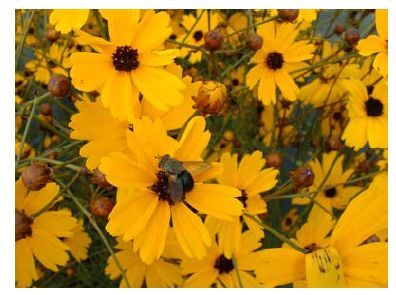
The plants were visually appealing from late June until mid-August, when deer started to feed on them (Figure 1). Deer ate plants to the soil line. Five or more flowers per plant occurred on August 8 (Table 3). Interestingly, container-grown plants and those in seed production plots at the NFREC typically begin to flower in late October. A scale infestation was observed on August 8, but deer feeding precluded identification of the scale. No measurements were recorded because the plants did not reach peak bloom due to deer browsing. Plants persisted to winter, but most did not reemerge the following spring.
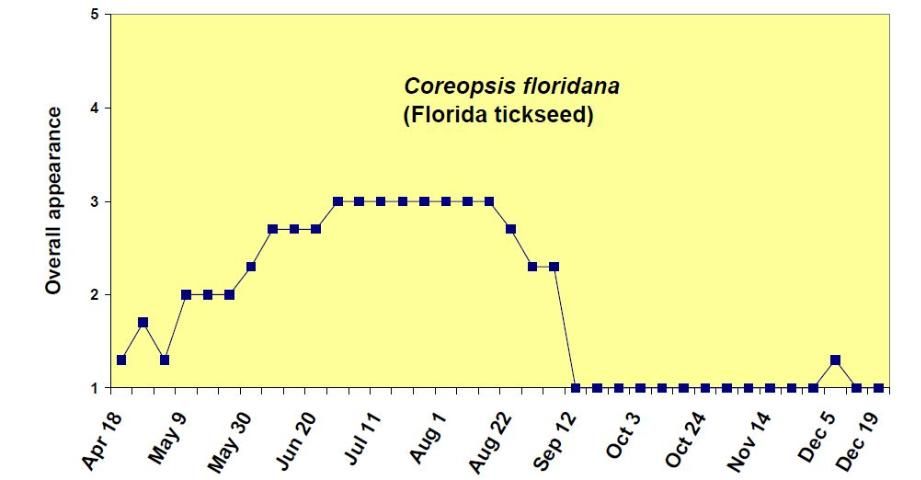
Coreopsis grandiflora (Largeflower Tickseed)
Description—Natural Habitat
Largeflower tickseed is a short-lived perennial to perennial. Both the disc flowers and ray flowers are yellow. In Florida, it has been documented in only two counties—Liberty and Lafayette. Flowering in north Florida occurs in July. This species occurs in sites with partial shade to full sun and well-drained soil.
Landscape Performance
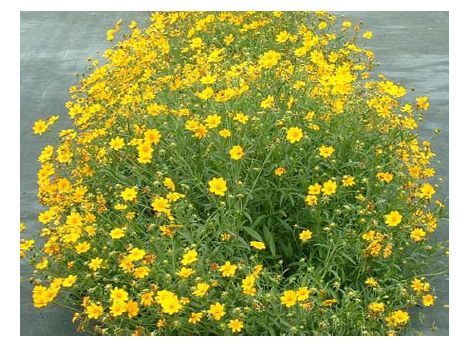
Peak performance of largeflower tickseed was in early June (Figure 2). Plants were rated very good to good from mid-May to mid-September. Five or more flowers per plant occurred from May 30 to December 5. An unidentified leaf spot was observed sporadically during the entire evaluation period, and there was slight damage from chewing insects and leaf miners.
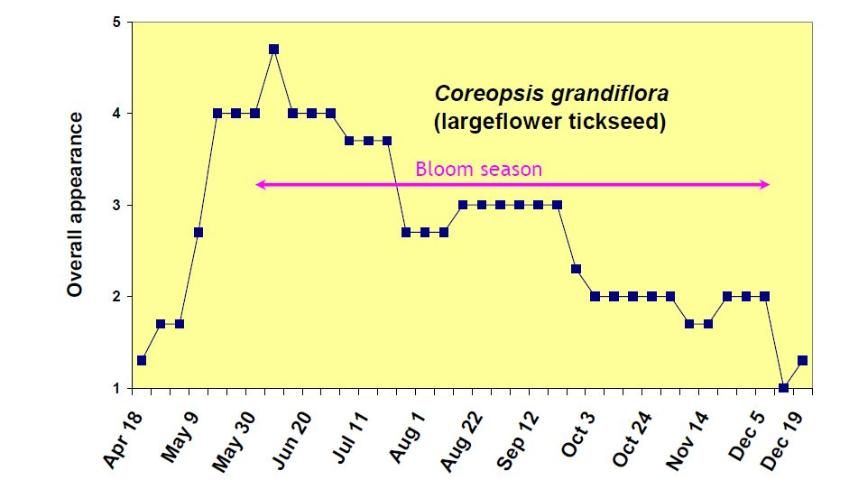
Coreopsis lanceolata (Lanceleaf Tickseed)
Description—Natural Habitat
Lanceleaf tickseed is a clump-forming, short-lived, evergreen to semi-evergreen perennial. It has lance-shaped leaves principally found at the base of the plant. The main flowering season in north Florida is late March and into May. Both ray flowers and disc flowers are yellow. It primarily occurs in the panhandle and northern peninsular Florida. Lanceleaf tickseed prefers full sun in a dry to slightly moist but well-drained soil. It can tolerate light shade and occasional freezes to the mid-20s.
Landscape Performance
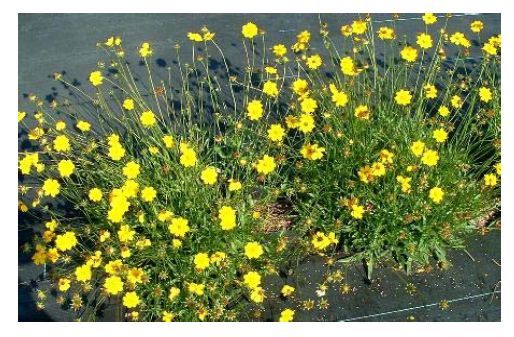
Peak performance was from early May to early June, with good overall appearance until about mid-September and fair appearance until early December (Figure 3). Flowering commenced in late April and peaked in late May, but there were at least 5 open flowers per plant until December (Table 3). There was slight insect damage from chewing insects and thrips. Slight disease damage (leaf spot) was observed starting in mid-October.
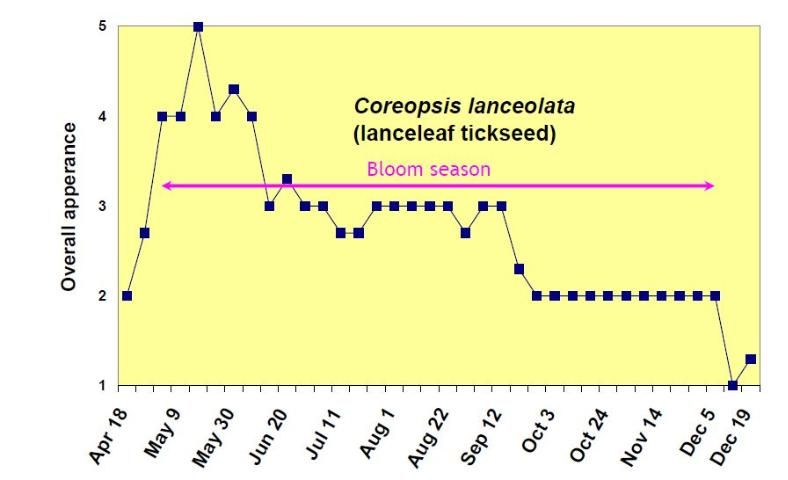
Coreopsis leavenworthii (Leavenworth's Tickseed)
Description—Natural Habitat
Leavenworth's tickseed occurs throughout Florida and is most often found growing in sunny sites with slightly moist to moist soils. In northern Florida it tends to be an annual, but it is a short-lived perennial farther south. The showy ray flowers are yellow, and disc flowers are dark brown. Flowering season in north Florida is mainly from late spring through late summer.
Landscape Performance

Peak performance occurred on May 30 (Figure 4). Overall appearance was rated very good to good from mid-May to mid-August. There were 5 or more flowers per plant from May 23 to November 14 (Table 3). Slight insect damage was observed during July and August.
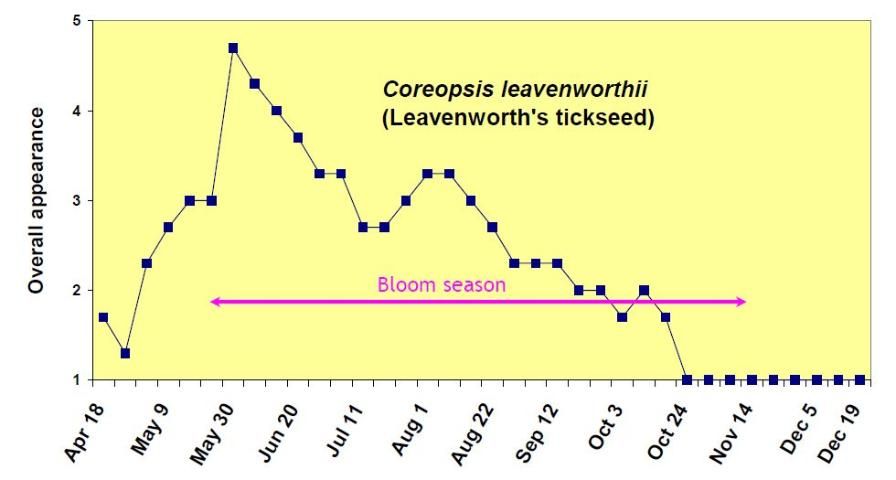
Coreopsis nudata (Georgia Tickseed)
Description—Natural Habitat
Georgia tickseed, which is locally known as swamp tickseed, is a tall (up to 5 ft), shortlived perennial to perennial. The local name is appropriate because it occurs along swamp edges and other moist to wet sites with rich soils such as ditches, swales, and pond margins. Its purplish to pinkish ray flowers make it the only native tickseed of its kind in Florida. All other native ones have yellow ray flowers. This species, which only occurs in north Florida, is often seen flowering in rural, roadside ditches as early as March but as late as June. Leaves also are unique among Florida's native tickseeds in that they are rush-like.
Landscape Performance
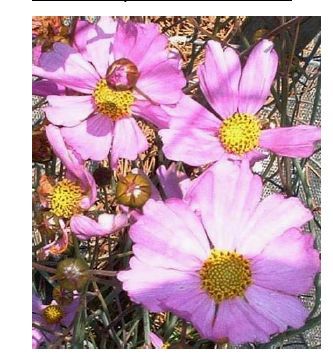
Some plants died after transplanting, with those that survived not rated very highly because none of them flowered. Sometime after July 5, the deer found this tickseed to be very palatable (Figure 5). The plants never got more than a few inches tall before deer would eat them almost to the soil line. Plants survived this heavy feeding and in December were enclosed in a wire cage to allow them to overwinter. Some minor insect feeding was noted. In the greenhouse, charcoal rot (Macrophomina phaseolina) has been a problem.
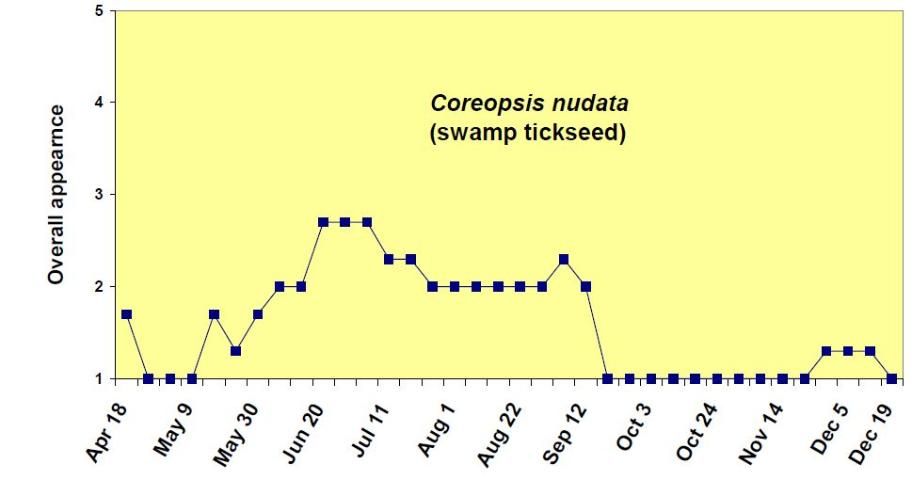
Coreopsis pubescens (Star Tickseed)
Description—Natural Habitat
Star tickseed, like lanceleaf tickseed, is an evergreen to semi-evergreen perennial with yellow ray and disc flowers. Unlike lanceleaf tickseed, it typically blooms in August and September. Star tickseed occurs in only four western panhandle counties and prefers a slightly moist to slightly dry, but well-drained soil.
Landscape Performance
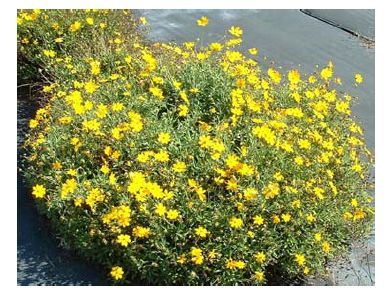
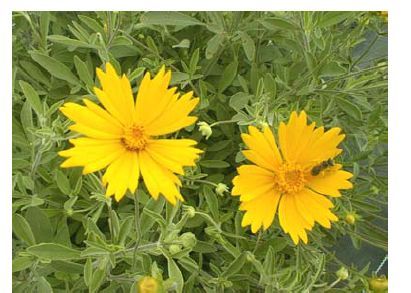
Peak performance was during June (Figure 6). Good overall appearance occurred from mid-May to near the end of November. Noticeable flowering occurred from late May to early December.
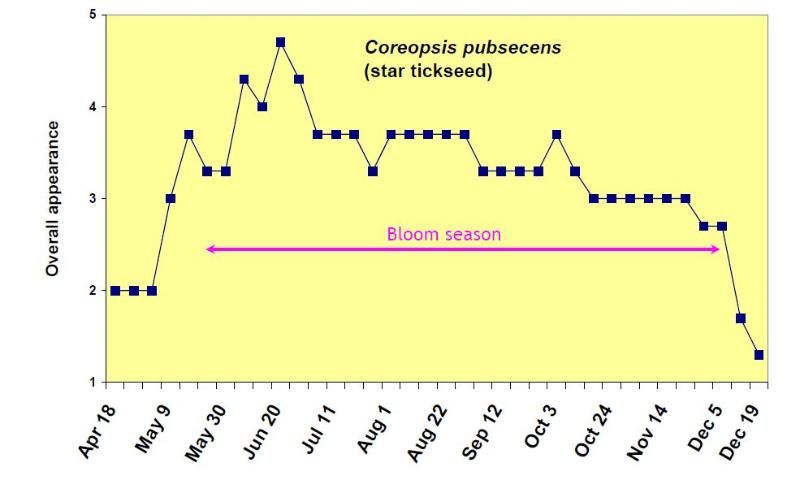
Flaveria linearis (Narrowleaf Yellowtops)
Description—Natural Habitat
Narrowleaf yellowtops is a perennial mainly found in coastal counties of peninsular Florida, with the only documented populations in north Florida in Wakulla and Taylor Counties. It is the only native Flaveria that occurs in the panhandle; a nonnative species, F. bidentis, occurs in Escambia County. Narrowleaf yellowtops typically occurs in moist sites in coastal areas, hammocks, pinelands, and ditches. Flower heads are composed of many small yellow, tubular disc florets; many of the disc florets have a single yellow ray flower. While narrowleaf yellowtops has been observed blooming as early as August, it typically flowers in mid to late fall in north Florida.
Landscape Performance
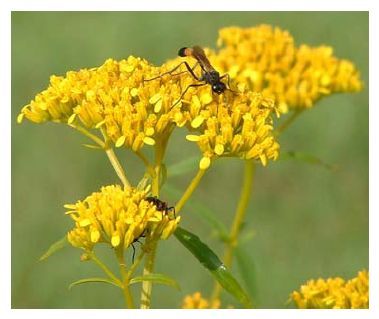

Overall plant appearance was rated good or better from early June to mid-October 17, with plants rated as excellent at the end of August (Figure 7). Five or more flower heads per plant occurred from July 18 to December 19 (Table 3). By season's end, a single plant was close to 5 ft tall and 6 ft wide.There were insects (possibly a seed beetle) that appeared on mature seed heads, but their impact was unknown. A minor leaf spot infestation started in mid-October but had no impact on overall appearance.
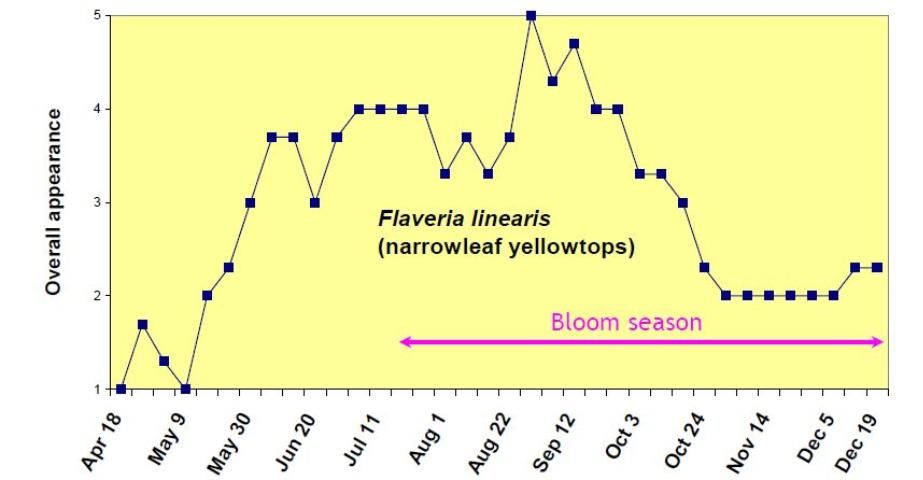
Gaillardia pulchella (Firewheel)
Description—Natural Habitat
Firewheel, also known as blanketflower and Indian blanket, is an annual to short-lived perennial. While it occurs throughout the state, firewheel only has been documented in about half of Florida's counties. This species is often found in coastal areas. Ray flowers typically have an inner band of red and an outer band of yellow, although the relative amounts can vary substantially to the point that some flowers are solid red or yellow. Occasionally, the yellow in ray flowers is replaced by white, resulting in a rosecolored flower. White flowers have been observed but are very rare. Typically, firewheel flowers from very late spring through early fall in north Florida.
Landscape Performance

From early May to early December, overall apperance was rated good to excellent, with plants rated very good to excellent for most of the summer (Figure 8). Five or more flowers per plant occurred from May to December, (Table 3). By December, plants were nearly 6 ft wide and 3 ft tall, which is three times wider and twice as tall compared to plants in the wild. Minor thrips damage to foliage was observed.
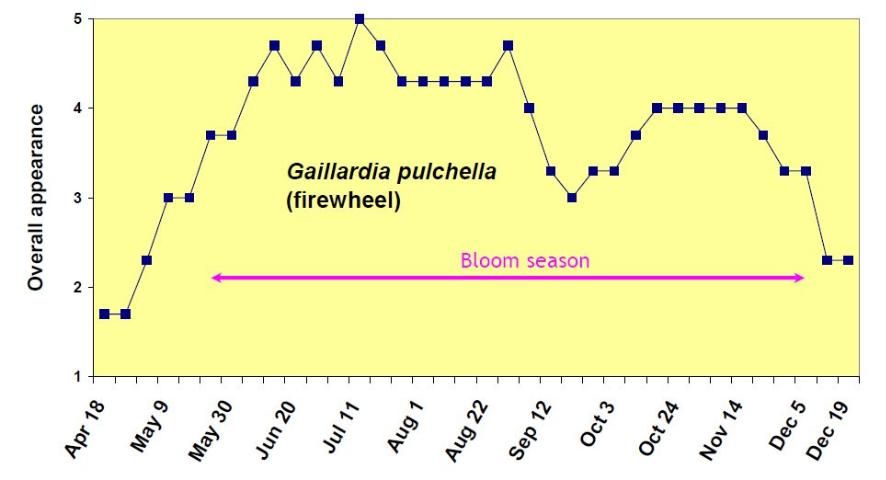
Ipomopsis rubra (Standing Cypress; Spanish Larkspur)
Description—Natural Habitat
Standing cypress is listed as a biennial, although we have observed that some plants may be annual to short-lived perennials in north Florida. It mainly occurs in northern peninsular Florida but occurs in Leon and Escambia Counties as well. Standing cypress typically is found in coastal dunes, sandhills, and dry pinelands. Tubular red flowers are borne on upper half of the 2- to 5-ft solitary stems. In north Florida, flowering typically occurs in summer. Multiple shorter stems occur when the growing tip is destroyed by an animal, mowing, etc. The stem has fine, cypress-like foliage, and when not flowering it resembles dogfennel.
Landscape Performance
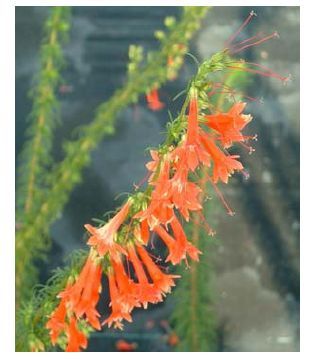
From mid-May to mid-November overall appearance was rated as good or better, with peak performance from early August to mid-October (Figure 9). Some plants had the typical solitary stem, while others were multistemmed. There were 5 or more flowers per plant from August to December (Table 3). Some disease damage was observed in late May and early June. Previously, we noted that standing cypress in north Florida landscape plantings was severely damaged by Fusarium.
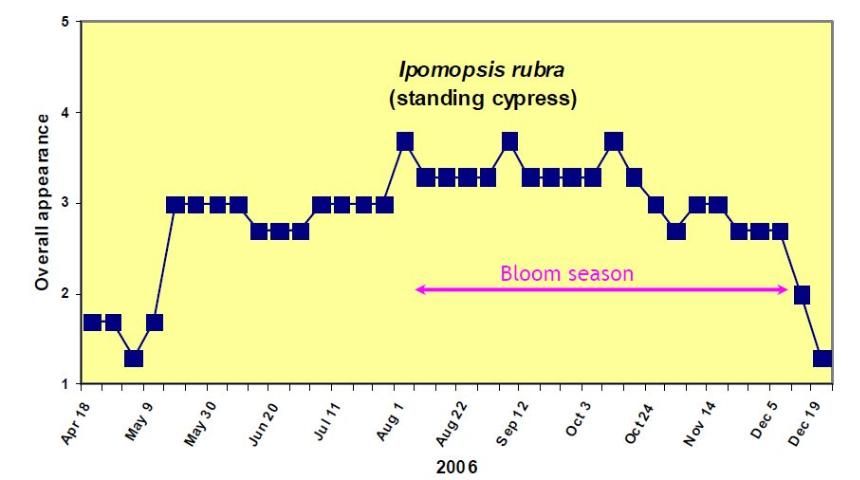
Liatris gracilis (Slender Grayfeather)
Description—Natural Habitat
Slender gayfeather is a perennial found throughout Florida in sandhills or flatwoods. It is a tall upright plant that normally has solitary stems on which an abundance of showy purple flowers are borne in late summer and early fall in north Florida. Taller plants tend to lean to one side or nearly fall over.
Landscape Performance
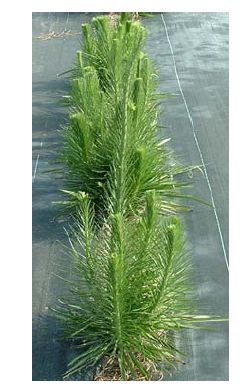
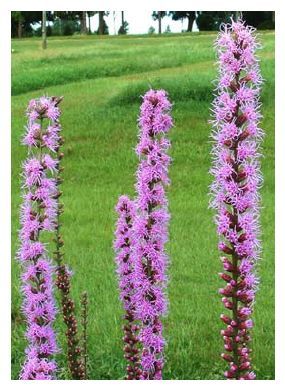
Overall visual appeal was rated good starting in mid-June and continued until early October, with peak performance in mid-September (Figure 10). The picture on the left illustrates that plants were multi-branched and had relatively dense foliage under landscape conditions. Five or more open flowers per plant occurred from August 29 until October 10 (Table 3). Except for some minor insect damage during establishment, no insect or disease problems were observed.
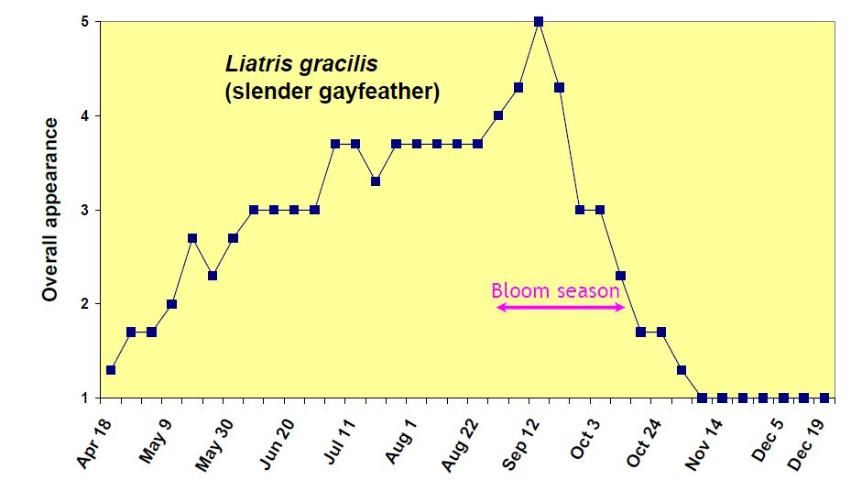
Mimosa strigillosa (Powderpuff)
Description—Natural Habitat
Powderpuff, also known as sunshine mimosa, is a perennial, mat-forming ground cover. This fine textured legume has stems that become woody over time and are nonprickly (to distinguish it from M. quadrivalvis, which has a prickly stem). Distribution in Florida is throughout the peninsula, with the western edge of its range being Leon County. Powderpuff often occurs in disturbed, well-drained sites; its occurrence along roadsides seems to have increased substantially over the past few years. This species, which is aptly named for the shape of its showy purple flowers, typically blooms in May in north Florida.
Landscape Performance
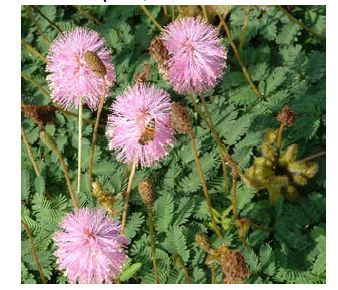

From the end of May to early November, powderpuff was rated good or better with peak performance during the month of August (Figure 11). Five or more blooms per plant, which occurred on new growth, were observed from June 27 to December 5 (Table 3). By theend of growing season, the 10 transplants had converged to form a mat that covered nearly 200 sq. ft.

Rudbeckia mollis (Softhair Coneflower)
Description—Natural Habitat
Softhair coneflower is a biennial, although some plants are annual or short-lived perennials. It is most often found growing in dry, sandy sites with well-drained soils in north Florida as far west as Walton County. Disc flowers are dark purple and ray flowers are yellow. This species is appropriately named as both the leaves and upper stems are wooly.
Landscape Performance
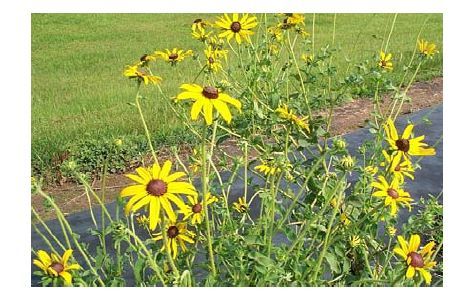
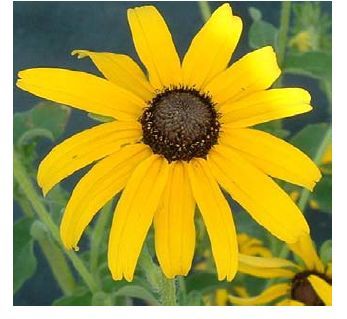
Overall appearance was rated good or better from mid- June to early August, with peak performance in early to mid July (Figure 12). Five or more flowers per plant were observed from June 20 to August 29 (Table 3). Root rot and wind damage were problematic, especially after the plants had fully matured. Chewing insects were a minor problem on young plants.
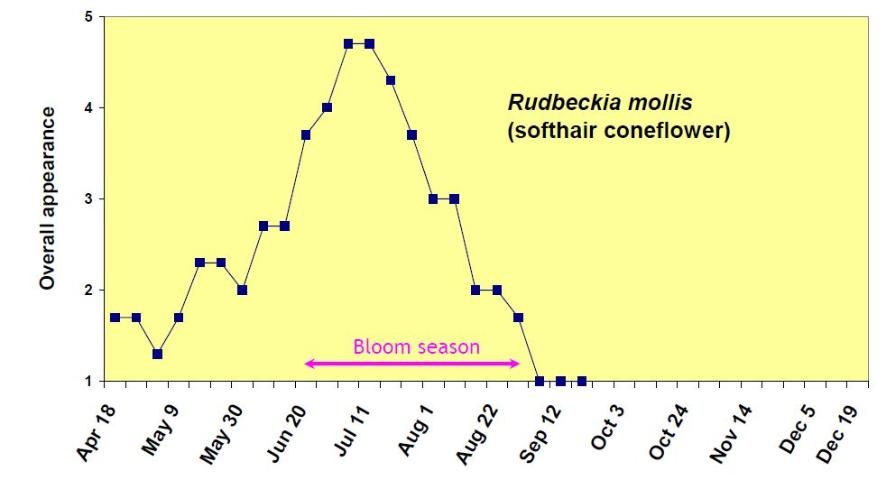
Senna mexicana var. chapmanii (Champman's Wild Sensitive Plant)
Description—Natural Habitat
Chapman's wild sensitive plant is a threatened species in Florida (that is, it's in rapid decline in Florida) found only in pinelands, hammocks, and dunes of Miami-Dade County and the Keys. This perennial legume has yellow orange flowers clustered near the tips of the stems. Typically the flowering season is March to May.
Landscape Performance
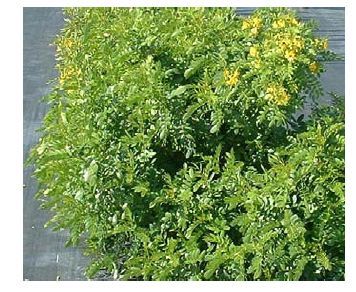
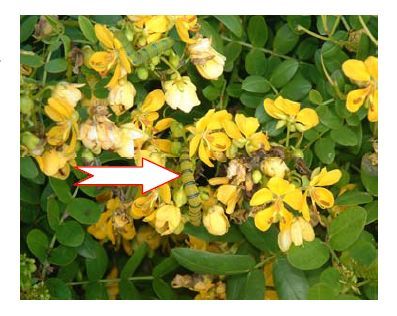
Overall appearance was good or better from the end of June to mid-August (Figure 13), and again from mid- September to mid- November. These ratings mirrored the two blooming seasons we observed (Table 3). In mid-August, sulphur butterfly larvae (see arrow in picture on right) were observed feeding on the flowers and foliage, which caused a substantial decline in plant appearance. Sulphur butterfly larvae began feeding again in mid to late October, and by late November plants were decimated.
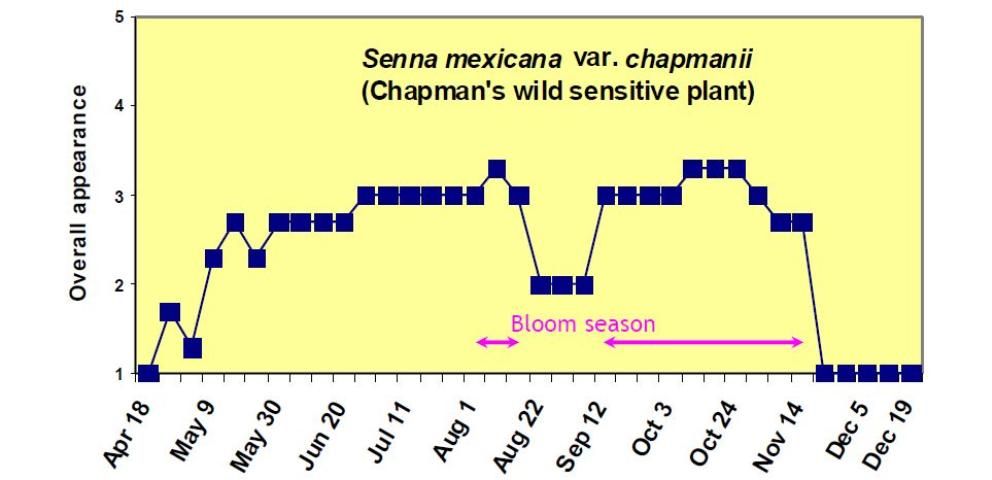
Stokesia laevis (Stokes' Aster)
Description—Natural Habitat
Stokes' aster is a perennial that is of limited distribution from Escambia to Nassau Counties. It typically grows in partial to full shade in moist soils. The showy purple ray flowers surround the purplish to creamy white disc flowers. Flowering season is from June to August in north Florida.
Landscape Performance
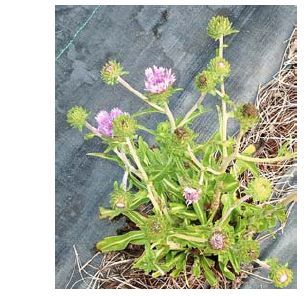
From late June to late July, overall appearance of Stokes' aster was rated as good to very good, with the peak during early to mid-July (Figure 14). Deer browsing caused the decline after July 25 (Figure 14) and shortened the bloom period to 2 weeks (Table 3). Two of the six plants died after transplanting. Only temporary insect damage was apparent. Browning and dieback of a few of the basal leaves were noted from time to time.
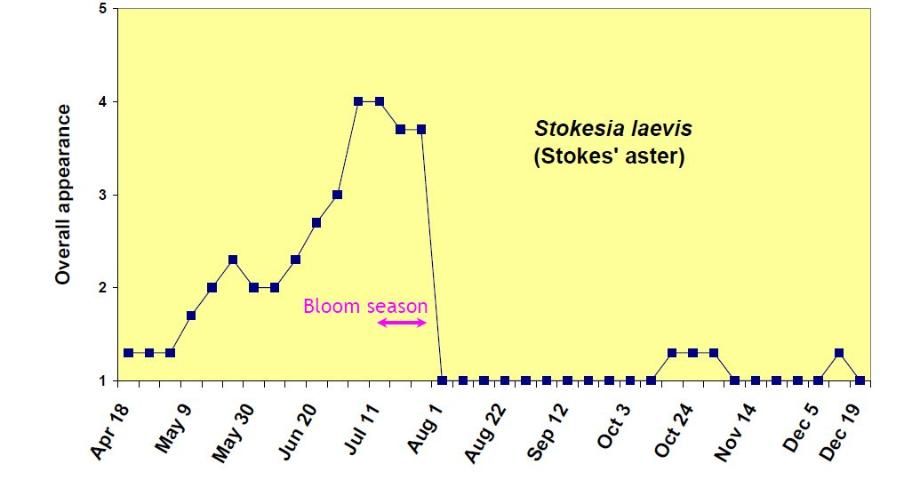
Tridens flavus (Tall Retop; Purpletop Tridens)
Description—Natural Habitat
Purpletop tridens was the only grass evaluated. It is a perennial bunch grass with an open habit, sparse foliage, and reddish purple inflorescences. It is found in most counties throughout the state under a wide variety of soil, moisture, and light conditions except full shade.
Landscape Performance
Purpletop tridens was a much fuller, more densely foliated plant compared to plants in the wild. It was one of the favorites of the evaluators, who rated it good or better from late May to mid-November and excellent during peak flowering in late September (Figure 15). There was minor insect chewing damage noted early in the evaluation period. Leaf spot was minor and occurred late in the year.
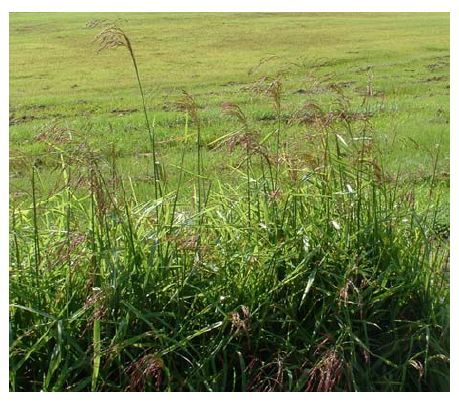
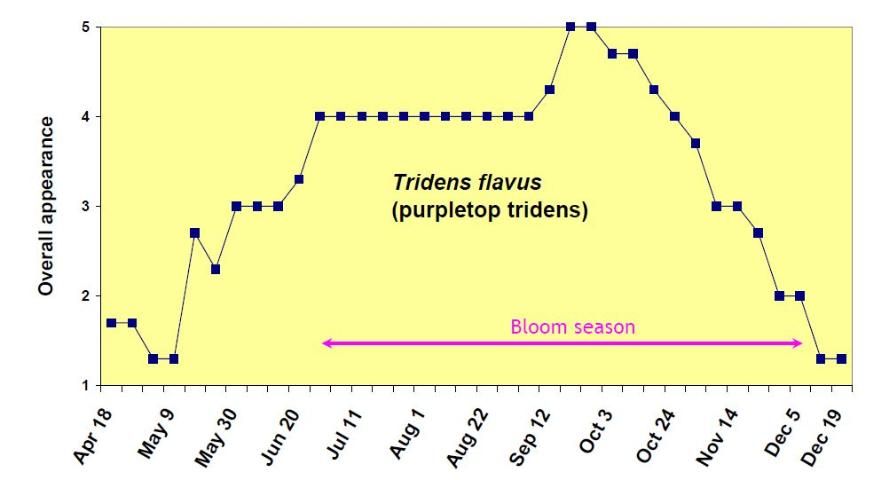
Acknowledgements
Special thanks to volunteers Richard Thompson, JoAnne Gordon, Maribeth Wood, and the UF/IFAS NFREC staff including Amanda Brock, Tom Batey, and Emily Wright for assisting with greenhouse plant production, installation, maintenance, and evaluations. Thanks to John Payne, Terry Zinn Harriet Wright, and oather Florida Wildflower seed producers for providing seeds.
Tables
Native wildflowers evaluated under landscape conditions at the UF/IFAS NFREC-Quincy from April 18 to December 2006.
Temperatures and rainfall at the UF/IFAS NFREC in Quincy from April 1 through December 19, 2006.